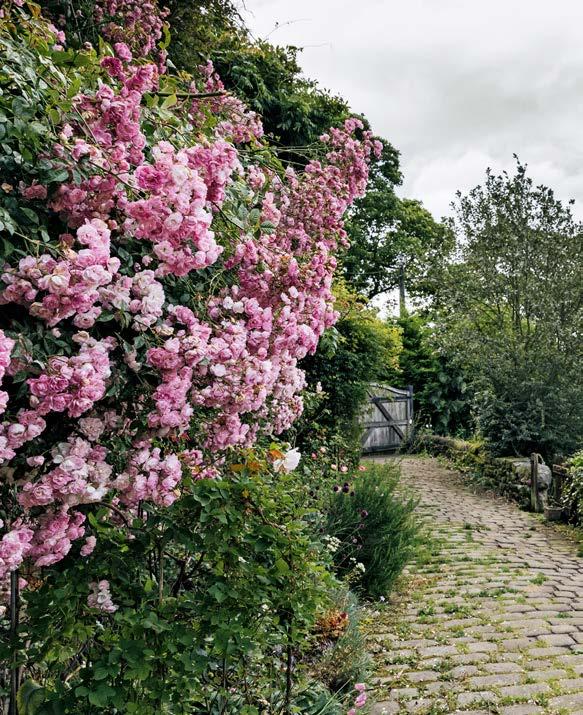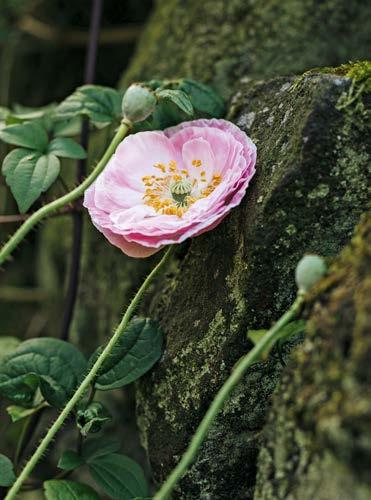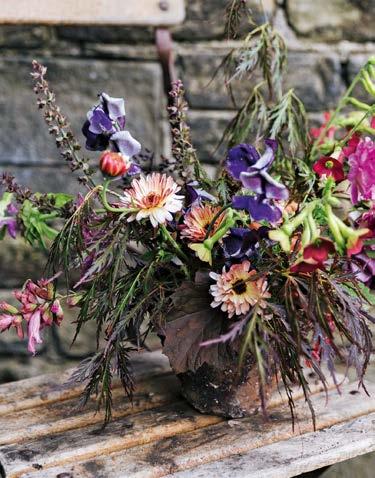
8 minute read
Firenza Flowers Florist Fiona Pickles
The best sort of garden is one into which its owner goes every day of the year, using it for inspiration and reflection in every season whatever the weather. You might expect a florist’s garden to be full of roses and other big statement flowers, but Fiona Pickles, of Firenza Flowers, is no ordinary florist. In her West Yorkshire garden, which clings to a steep hillside overlooking the Ryburn Valley, she is more likely to snip wispy tendrils of clematis, the seedheads of scabious and poppy or even a ‘weed’ like shepherd’s purse, than cut the more showy flowers. Her maiden name was Wilde – apt for someone who has taken her skill as one of the country’s most sought-after florists in a direction that is more in harmony with the natural world than the perfection of the florist’s window.
Fiona and her husband Brian moved here 13 years ago when the garden was far more formal – too tidy even. “It had a neat lawn, the stone setts were pressure-washed to within an inch of their life and there was clipped box everywhere. It didn’t feel like mine,” Fiona recalls. She had left a successful career in the print industry, which had helped develop her eye for detail, to pursue a career in wedding floristry – “lots of roses and peonies in pastel colours” – even though she now considers that what she did then was ‘not her’. “I was going further and further down a creative route that left me empty,” she explains. While she recognised this, she did not know how to change. Once during those early days she was asked to take part in a florists’ photoshoot, creating a bouquet and buttonhole. “I incorporated flowers and foliage from my garden, but was embarrassed because they were ‘just’ seasonal garden flowers: I felt they were somehow inferior.”
Then, in March 2013, a chance happening changed her life. She attended the annual meeting of the artisan British flower growers’ group, Flowers from the Farm, then a very small organisation. “It was a light-bulb moment,” she remembers. “They were growing flowers with character, style and scent – elements you can’t always get from imported blooms – and I knew these were the people I wanted to be around. I loved everything they were talking about.” Although other florists were startled by her new ethos, she was enthusiastic about using British flowers and knew this was the direction in which she wanted to take her career. But then her mother,

Above left Informal beds are filled with a riot of flower forms and foliage, that are ripe for picking. Above right Pink clouds of pretty rambling rose ‘Belvedere’ billow along the cobbled driveway.


Rudbeckia ‘Sahara’ Rosa ‘Pumpkin Patch’ Rosa ‘Desdemona’

Rudbeckia ‘Sahara’


Nigella damascena

Rosa ‘Belvedere’
Hydrangea paniculata Persicaria amplexicaulis


Shirley poppies

Shirley, a lifelong gardener and a huge inspiration, became very ill in the middle of Fiona’s busiest ever year. She cared for her mother and carried on working, providing fl owers for over 40 weddings in six months. In the spring of 2014, her mother died.
In early 2015, exhausted by a heavy workload and grieving her mother’s death, Fiona took a step back from fl oristry. She headed o on a road trip to visit fl ower growers and gardens that inspired her, before reinventing her business, Firenza Flowers, in line with her new style and approach. Over the past fi ve years she has turned her back on imported blooms, using British fl owers instead, not just for environmental reasons – although typically homegrown fl owers have less than ten per cent of the carbon footprint of imports – but because they give her the movement she wants. “The fl owers have


Top left Fiona cuts stems of purple-leaved Lysimachia ciliata. Top right A large clump of veronicastrum, a perennial with the ‘wild’ look that Fiona loves. Above An arrangement of fl owers, Firenza style. the shape, the personality, the colours and character, and if the stems aren’t all straight, so much the better. Most of what I use now comes from artisan growers about an hour and a half away.” In the early days it wasn’t easy. Florists order their fl owers online from big wholesalers who deal almost exclusively in imports, and the fl owers arrive the next morning. The fi rst wedding for which Fiona used exclusively British fl owers involved journeys to six di erent growers – but as more and more growers have come on stream, this has become easier. “There was no business sense in it, but I changed the way I work because it’s important to me,” she explains.
She also turned her attention back to her garden, which had been neglected throughout 2014, and set about changing it completely. Out came the manicured box, the lawn was dug up, a winding path replaced the straight one and she let the garden have its head. “I’ve messed it up; it’s much more me, and I’ve put in the kind of plants I use in my fl oristry:


heuchera, hellebores, hydrangeas and scabious,” says Fiona. “It’s much more tangled, but completely immersive. I teach one-to-one workshops here and my students come in and pick whatever takes their fancy.” The garden often appears to have no boundaries, blending into the spectacular moorland views. Even the rambling roses, clematis and honeysuckle are allowed to romp vigorously over the house, at times appearing to engulf it like a flowery thicket in a fairy tale.
The countryside surrounding the house is a creative wellspring. Through mature sycamores, the views out across the moors include dry stone walls that seem to defy gravity, disappearing straight up the fellside. “That’s probably why I’m so drawn to brown, sludgy colours,” says Fiona, “because the landscape here is so many shades of brown, purple and dark green.” Even the luxuriant covering of moss on her roof and garden walls – and this being the north of England, moss comes with the territory – is left alone because she loves its colour and texture. In the setts around the house, a small meadow of self-sown Shirley poppies flower between the cracks. When her mother died, Fiona put thousands of the poppies’ seeds in hand-printed packets for the mourners, so that come flowering time, they would recall her mother’s memory. Initially she had planted the poppies close to the house, but gradually they migrated out into the garden, blooming abundantly each year.
Flowers at their peak often do not catch her attention. If anything, she likes to wait until they have faded, taking on subtle new shades and a character of their own. A blown rose attracts her more than a perfect one; a leaf with brown curling edges more likely to take centre stage than a fresh green one. On her Instagram feed, her 40,000 followers are often surprised and amused when she posts some of her more ethereal creations, for this is a glorious kind of anti-floristry. She also creatively curates large, dramatic flower festivals, like Castle Howard in 2018, using exclusively British flowers. When she is demonstrating she takes her lead from how things want to twist, turn and weave rather than forcing the natural into the unnatural. She thinks it is all too easy to get sucked into doing what other florists are doing, especially when you see beautiful things on social media: “I would say work with what you’ve got. Even if I tried, I couldn’t be perfect and neat. I’ve got messy hair and messy clothes, so even if I try it always ends up looking rugged and imperfect. But I like that. It’s me.”
There is so much call for tuition in her style, that she regularly travels all over the world, holding workshops and classes and teaching florists new ways of thinking about flowers and foliage. But it is in her garden that she is most herself, absorbed in what she sees, the light, the way things twist, grow and fade and the constant shifting mood of the moors, moving around with her florist’s snips, dreaming up new ways with fading flowers.
Above left Simple Shirley poppies and nostalgic Rosa ‘Belle Epoque’ are typical of Fiona’s informal style of flower arranging. Above right A loose arrangement with acer foliage and phygelius.

For more information visit firenzafloraldesign.co.uk or follow Fiona on Instagram @firenzaflowers

Bottled Botanics
From beautiful gardens spread across 50 acres of the Tarrant Valley, David and Julia Bridger capture the home-grown scents of Dorset to produce a small range of limited-edition perfumes for their company, Parterre Fragrances
WORDS LOUISE CURLEY PHOTOGRAPHS REBECCA BERNSTEIN
Fields of aromatic flower and foliage crops are grown on the Keyneston Mill Estate in Dorset for Parterre Fragrances.









